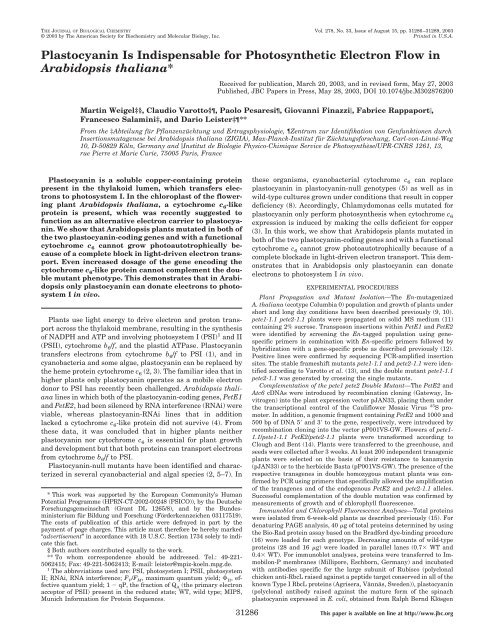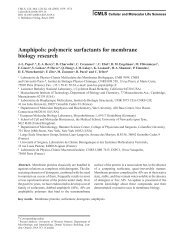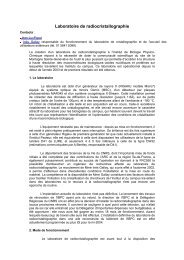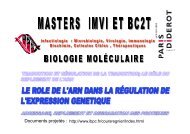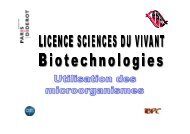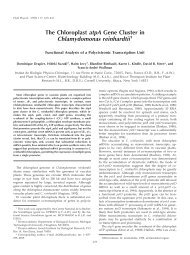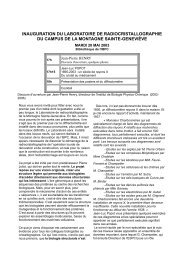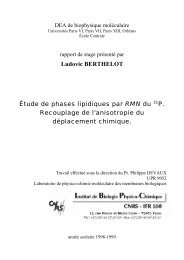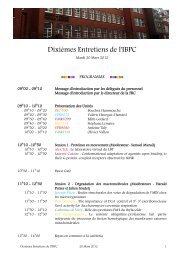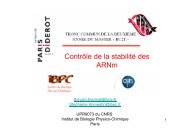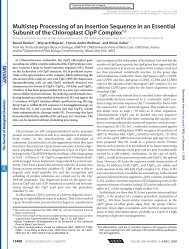Weigel M., Varotto C., Pesaresi P., Finazzi G., Rappaport F ...
Weigel M., Varotto C., Pesaresi P., Finazzi G., Rappaport F ...
Weigel M., Varotto C., Pesaresi P., Finazzi G., Rappaport F ...
Create successful ePaper yourself
Turn your PDF publications into a flip-book with our unique Google optimized e-Paper software.
THE JOURNAL OF BIOLOGICAL CHEMISTRY Vol. 278, No. 33, Issue of August 15, pp. 31286–31289, 2003© 2003 by The American Society for Biochemistry and Molecular Biology, Inc. Printed in U.S.A.Plastocyanin Is Indispensable for Photosynthetic Electron Flow inArabidopsis thaliana*Received for publication, March 20, 2003, and in revised form, May 27, 2003Published, JBC Papers in Press, May 28, 2003, DOI 10.1074/jbc.M302876200Martin <strong>Weigel</strong>‡§, Claudio <strong>Varotto</strong>§, Paolo <strong>Pesaresi</strong>, Giovanni <strong>Finazzi</strong>, Fabrice <strong>Rappaport</strong>,Francesco Salamini‡, and Dario Leister‡**From the ‡Abteilung für Pflanzenzüchtung und Ertragsphysiologie, Zentrum zur Identifikation von Genfunktionen durchInsertionsmutagenese bei Arabidopsis thaliana (ZIGIA), Max-Planck-Institut für Züchtungsforschung, Carl-von-Linné-Weg10, D-50829 Köln, Germany and Institut de Biologie Physico-Chimique Service de Photosynthèse/UPR-CNRS 1261, 13,rue Pierre et Marie Curie, 75005 Paris, FrancePlastocyanin is a soluble copper-containing proteinpresent in the thylakoid lumen, which transfers electronsto photosystem I. In the chloroplast of the floweringplant Arabidopsis thaliana, a cytochrome c 6 -likeprotein is present, which was recently suggested tofunction as an alternative electron carrier to plastocyanin.We show that Arabidopsis plants mutated in both ofthe two plastocyanin-coding genes and with a functionalcytochrome c 6 cannot grow photoautotrophically becauseof a complete block in light-driven electron transport.Even increased dosage of the gene encoding thecytochrome c 6 -like protein cannot complement the doublemutant phenotype. This demonstrates that in Arabidopsisonly plastocyanin can donate electrons to photosystemI in vivo.Plants use light energy to drive electron and proton transportacross the thylakoid membrane, resulting in the synthesisof NADPH and ATP and involving photosystem I (PSI) 1 and II(PSII), cytochrome b 6 /f, and the plastid ATPase. Plastocyanintransfers electrons from cytochrome b 6 /f to PSI (1), and incyanobacteria and some algae, plastocyanin can be replaced bythe heme protein cytochrome c 6 (2, 3). The familiar idea that inhigher plants only plastocyanin operates as a mobile electrondonor to PSI has recently been challenged. Arabidopsis thalianalines in which both of the plastocyanin-coding genes, PetE1and PetE2, had been silenced by RNA interference (RNAi) wereviable, whereas plastocyanin-RNAi lines that in additionlacked a cytochrome c 6 -like protein did not survive (4). Fromthese data, it was concluded that in higher plants neitherplastocyanin nor cytochrome c 6 is essential for plant growthand development but that both proteins can transport electronsfrom cytochrome b 6 /f to PSI.Plastocyanin-null mutants have been identified and characterizedin several cyanobacterial and algal species (2, 5–7). In* This work was supported by the European Community’s HumanPotential Programme (HPRN-CT-2002-00248 (PSICO)), by the DeutscheForschungsgemeinschaft (Grant DL 1265/8), and by the Bundesministeriumfür Bildung und Forschung (Förderkennzeichen 03117519).The costs of publication of this article were defrayed in part by thepayment of page charges. This article must therefore be hereby marked“advertisement” in accordance with 18 U.S.C. Section 1734 solely to indicatethis fact.§ Both authors contributed equally to the work.** To whom correspondence should be addressed. Tel.: 49-221-5062415; Fax: 49-221-5062413; E-mail: leister@mpiz-koeln.mpg.de.1 The abbreviations used are: PSI, photosystem I; PSII, photosystemII; RNAi, RNA interference; F V /F M , maximum quantum yield; II ,effectivequantum yield; 1 qP, the fraction of Q A (the primary electronacceptor of PSII) present in the reduced state; WT, wild type; MIPS,Munich Information for Protein Sequences.31286these organisms, cyanobacterial cytochrome c 6 can replaceplastocyanin in plastocyanin-null genotypes (5) as well as inwild-type cultures grown under conditions that result in copperdeficiency (8). Accordingly, Chlamydomonas cells mutated forplastocyanin only perform photosynthesis when cytochrome c 6expression is induced by making the cells deficient for copper(3). In this work, we show that Arabidopsis plants mutated inboth of the two plastocyanin-coding genes and with a functionalcytochrome c 6 cannot grow photoautotrophically because of acomplete blockade in light-driven electron transport. This demonstratesthat in Arabidopsis only plastocyanin can donateelectrons to photosystem I in vivo.EXPERIMENTAL PROCEDURESPlant Propagation and Mutant Isolation—The En-mutagenizedA. thaliana (ecotype Columbia 0) population and growth of plants undershort and long day conditions have been described previously (9, 10).pete1-1.1 pete2-1.1 plants were propagated on solid MS medium (11)containing 2% sucrose. Transposon insertions within PetE1 and PetE2were identified by screening the En-tagged population using genespecificprimers in combination with En-specific primers followed byhybridization with a gene-specific probe as described previously (12).Positive lines were confirmed by sequencing PCR-amplified insertionsites. The stable frameshift mutants pete1-1.1 and pete2-1.1 were identifiedaccording to <strong>Varotto</strong> et al. (13), and the double mutant pete1-1.1pete2-1.1 was generated by crossing the single mutants.Complementation of the pete1 pete2 Double Mutant—The PetE2 andAtc6 cDNAs were introduced by recombination cloning (Gateway, Invitrogen)into the plant expression vector pJAN33, placing them underthe transcriptional control of the Cauliflower Mosaic Virus 35 S promoter.In addition, a genomic fragment containing PetE2 and 1000 and500 bp of DNA 5 and 3 to the gene, respectively, were introduced byrecombination cloning into the vector pP001VS-GW. Flowers of pete1-1.1/pete1-1.1 PetE2/pete2-1.1 plants were transformed according toClough and Bent (14). Plants were transferred to the greenhouse, andseeds were collected after 3 weeks. At least 200 independent transgenicplants were selected on the basis of their resistance to kanamycin(pJAN33) or to the herbicide Basta (pP001VS-GW). The presence of therespective transgenes in double homozygous mutant plants was confirmedby PCR using primers that specifically allowed the amplificationof the transgenes and of the endogenous PetE2 and pete2-1.1 alleles.Successful complementation of the double mutation was confirmed bymeasurements of growth and of chlorophyll fluorescence.Immunoblot and Chlorophyll Fluorescence Analyses—Total proteinswere isolated from 6-week-old plants as described previously (15). Fordenaturing PAGE analysis, 40 g of total proteins determined by usingthe Bio-Rad protein assay based on the Bradford dye-binding procedure(16) were loaded for each genotype. Decreasing amounts of wild-typeproteins (28 and 16 g) were loaded in parallel lanes (0.7 WT and0.4 WT). For immunoblot analyses, proteins were transferred to Immobilon-Pmembranes (Millipore, Eschborn, Germany) and incubatedwith antibodies specific for the large subunit of Rubisco (polyclonalchicken anti-RbcL raised against a peptide target conserved in all of theknown Type I RbcL proteins (Agrisera, Vännäs, Sweden)), plastocyanin(polyclonal antibody raised against the mature form of the spinachplastocyanin expressed in E. coli, obtained from Ralph Bernd KlösgenThis paper is available on line at http://www.jbc.org
Role of Plastocyanin in Photosynthesis 31287FIG. 1. Isolation and characterizationof mutants for plastocyanin inA. thaliana. A, mutations in the lociPetE1 and PeteE2. En-transposon insertionswere located in the unique exons ofPetE1 and PeteE2, respectively. The proteinsencoded by the two genes are highlyhomologous, exhibiting in their matureforms (after cleavage of the chloroplasttransit peptide) a similarity/identity scoreof 93 and/or 83%. DNA sequences of thetransposon donor sites from independentgerminal revertants were obtained byPCR. Footprints left at each locus afterEn excision are indicated by boldface lowercaseletters, whereas bold uppercase lettersindicate the target site in the wildtypegene. Note that in pete1-1.1 a 52-bpsegment was deleted upon transposon excision,whereas a 1-bp frameshift occurredin pete2-1.1. B, immunoblot analysisof plastocyanin mutant and WTplants. 40 g of total leaf proteins fromWT and double-mutant plants wereloaded (lanes WT and pete1 pete2) togetherwith decreasing amounts of WTproteins (lanes 0.7 WT and 0.4 WT).Replicate filters were immunolabeledwith antibodies raised against the largesubunit of Rubisco (RbcL), plastocyanin,and cytochrome c 6 (Cyt c 6 ). C, phenotypesof WT plants and of the single mutantspete1-1.1 and pete2-1.1. Arabidopsisplants (8 weeks old) were grown in agreenhouse under long day conditions.The double mutant pete1-1.1 pete2-1.1does not survive under greenhouse conditions(data not shown). D, WTandpete1-1.1 pete2-1.1 plants (PC) grown on sucrose-containingMS medium andilluminated with white light (top) orUVlight (bottom). E, Northern analysis ofPetE2 and Atc6 transcripts in transgenicpete1-1.1 pete2-1.1 lines. Aliquots (30 g)of total RNA from WT and from pete1-1.1pete2-1.1 plants transformed with35 S::PetE2 or 35 S::Atc6 constructs werehybridized with cDNA probes specific forPetE2 and Atc6, respectively. To controlfor variation in loading, the blots werethen probed with an ACTIN1 cDNAfragment.(Martin-Luther-Universität Halle-Wittenberg, Germany)), and cytochromec 6 (polyclonal antibody raised against the mature form of theArabidopsis cytochrome C 6 expressed in E. coli (see also Ref. 4), obtainedfrom Sheng Luan (University of California, Berkeley, CA)). Signalswere detected using the Enhanced Chemiluminescence Westernblotting kit (Amersham Biosciences) and quantified using the LumiAnalyst 3.0 (Roche Applied Science). In vivo, Chl a fluorescence of singleleaves was measured using the PAM 101/103 device (Walz, Effeltrich,
31288Role of Plastocyanin in PhotosynthesisGermany) as described previously (12). Pulses (800 ms) of white light(6000 mol photonsm 2 s 1 ) were used to determine the maximumfluorescence (F M ) and the ratio (F M F o )/F M F V /F M . A 20-minillumination with actinic light (FL101/E; Walz, Effeltrich, Germany) ata rate of 80 mol photonsm 2 s 1 was used to drive electron transportbetween the two photosystems before measuring the effectivequantum yield of PSII ( II ) and photochemical quenching (qP (F M F S )/(F M F o )). Fluorescence induction kinetics were measured with ahome-made fluorometer (17). Actinic light was provided by an array ofgreen light emitting diodes (HLMP CM15, 520 nm, Hewlett-Packard).Light was concentrated on a leaf spot of 20 mm 2 , and fluorescence wasdetected on the opposite side of the sample. Emission was recorded atdiscrete times with a maximum resolution time of 30 s.FIG. 2.Kinetics of fluorescence emission in leaves of wild-typeand pete1 pete2 mutant plants. Light intensity was 80 molphotonsm 2 s 1 (50 photons/photosystem/s). 3-(3,4-Dichlorophenyl)-1-1-dimethylurea (DCMU) (10 M) was added by vacuum infiltration.Chlorophyll fluorescence is given as relative units (r.u.)RESULTS AND DISCUSSIONIn A. thaliana, we have isolated transposon insertion mutantsfor both plastocyanin-coding genes PetE1 (MIPS accessionnumber At1g76100) and PetE2 (MIPS accession numberAt1g20340). Starting from the unstable insertion mutants, stablenull alleles of both genes, pete1-1.1 and pete2-1.1, weregenerated by selecting germinal revertants with frameshiftmutations (Fig. 1A). The double mutant pete1-1.1 pete2-1.1 wasobtained by crossing single mutants and genotyping F2 progenies.In pete1-1.1 pete2-1.1 plants, no plastocyanin was detectableby immunoblot analysis, whereas wild-type amounts ofthe cytochrome c 6 polypeptide were found (Fig. 1B).In both pete1-1.1 and pete2-1.1 plants, growth was affected(Fig. 1C). The plastocyanin double mutants did not survive whengrown on soil but could be propagated in axenic culture on mediumsupplemented with sucrose. However, heterotrophicallygrown double mutants had a substantially reduced growth rateand displayed a high chlorophyll fluorescence phenotype uponillumination with UV light (Fig. 1D). This last observation indi-FIG. 3. Maximum likelihood phylogenetic trees based on an alignment of prokaryotic, algal, and plant cytochrome c 6 (A) andplastocyanin (B). Dark green branches indicate plant sequences, whereas algal and cyanobacterial sequences are indicated in light green andblue, respectively. Trees were constructed by protein maximum likelihood with PROTML (MOLPHY) (24) using the JTT-F matrix with theneighbor-joining tree of ML distances as the starting topology and RELL bootstrapping (10 4 ). Branch lengths reflect the estimated number ofsubstitutions/100 sites.
Role of Plastocyanin in Photosynthesis 31289cated that photosynthetic electron flow was blocked.Parameters of chlorophyll fluorescence induction were determinedto characterize the electron flow in the plastocyanindouble null mutant. Although the maximum (F V /F M ) quantumyield was decreased by 35% in pete1-1.1 pete2-1.1 plantscompared with the wild type (F V /F M : 0.54 0.04 versus 0.81 0.01), the effective quantum yield ( II ) was close to zero in thedouble mutant with respect to the wild type ( II : 0.04 0.01versus 0.74 0.02), again pointing to a severe perturbation inelectron flow. In addition, the fraction of Q A (the primaryelectron acceptor of PSII) present in the reduced state wasdrastically increased (1 qP: 0.94 0.01 versus 0.06 0.02),implying that electron flow through PSII is still occurring whilethe block exists at a later electron transfer step.Consistent with these data is the comparison of the fluorescenceinduction curves measured in the pete1-1.1 pete2-1.1mutant and wild-type plants (Fig. 2). Whereas the PSII photochemicalrate measured in the pete1-1.1 pete2-1.1 line was closeto that of the WT (data not shown), the area above the fluorescenceinduction curve (a parameter proportional to the size ofthe PSII acceptors; Refs. 18 and 19) was largely reduced in thismutant. This finding suggests that the size of PSII electronacceptor pool was largely decreased by the mutation. The areawas nevertheless larger than the one measured in the WT inthe presence of DCMU (to block the reoxidation of Q A ), confirmingthat the effect of the mutation was localized downstreamof PSII. As shown in Fig. 2, the mutant was blocked ina high fluorescence state, whereas in the WT, the fluorescenceyield started to decrease after approximately 10 s of continuousillumination. This decrease is at least partly attributable to theactivation of the Benson Calvin cycle (20). Its absence in themutant gives a further indication that electron transfer isblocked. Moreover, the mutant did not display the plateauobserved in the WT in the 20–100-ms time range during continuousillumination. This plateau has been recently ascribedto the reduction of PSI acceptors (see Ref. 17 for discussion). Itsabsence is consistent with a block of electron flow locateddownstream of the cytochrome b 6 /f. Taken together, these resultsstrongly strengthen the interpretation of the non-photoautotrophicmutant phenotype as the consequence of a completeblock in light-driven electron transport, which seems tooccur as expected at the level of the PSI donor side.To test whether increased doses of cytochrome c 6 can replaceplastocyanin in the pete1 pete2 double mutant, the ArabidopsiscDNA for cytochrome c 6 was fused to the 35 S promoter ofcauliflower mosaic virus and introduced into the pete1 pete2line. In all of the 35 S::Atc6 pete1 pete2 individuals analyzed,Atc6 mRNA was detected at high levels (Fig. 1E). However,unlike the case of the plastocyanin-overexpressing35 S::AtPetE2 construct that served as a positive control,35 S::Atc6 could neither reverse nor reduce the effects of thedouble mutation, indicating that cytochrome c 6 cannot replaceplastocyanin in vivo. Also, cytochrome c 6 expressed from T-DNA constructs containing the Atc6 gene under the transcriptionalcontrol of its natural promoter had no effect on thephenotype of the pete1 pete2 double mutant.The data concerning the photosynthetic behavior of the pete1pete2 double mutant are in conflict with the findings of Guptaet al. (4). Their oxygen evolution reconstruction assays indicatethat Arabidopsis cytochrome c 6 can function along with plastocyaninin photosynthetic electron transport (4). But doesArabidopsis cytochrome c 6 actually donate electrons to PSI invivo? Unlike the case in Chlamydomonas, cytochrome c 6 expressionin A. thaliana is constitutive and is not up-regulatedby plastocyanin depletion due to copper deficiency (4). Moreover,cytochrome c 6 of higher plants compared with that ofprokaryotes or algae may have acquired novel functions assuggested from phylogenetic analyses (Fig. 3). The plastocyaninsequences from Arabidopsis and several other plant speciesbranch from algal sequences, indicating a continuous evolutionfrom the cyanobacterial endosymbiont to the plastocyanin ofmodern chloroplasts. On the contrary, the cytochrome c 6 -likesequences of higher plants form a distinct clade, which is relativelydistantly related to both algal and cyanobacterial proteins.This indicates that higher plant cytochrome c 6 has diversifiedin sequence perhaps in association with the acquisition offunction(s) different from transferring electrons to PSI.The RNAi-based silencing of the genes for plastocyanin aswell as the combination of plastocyanin-RNAi and Atc6 knockoutwas performed in the Wassilewskija ecotype of A. thaliana(4), whereas the pete1 pete2 double mutant (this study) wasgenerated in the Columbia 0 background. However, it seemsimprobable that intraspecific variation in photosynthetic functionscould account for the difference in response. A secondpossibility can explain the contrasting results. Residual plastocyaninexpression can take place during RNAi because ofleakiness in gene silencing (21). Thus, the plastocyanin-RNAilines may have retained enough plastocyanin to allow a residuallevel of photosynthesis.If cytochrome c 6 cannot replace plastocyanin, at least inColumbia 0, what might its function be under normal physiologicalconditions? The protein might play a regulatory rolerather than quantitatively transferring electrons to PSI, or inlight of the results of recent proteomics analyses of the thylakoidlumen (22, 23), cytochrome c 6 could be involved in one ofthe diverse functions of the thylakoid lumen, including crosstalkingwith immunophilins with which it can interact in theyeast two-hybrid experiments (4).Acknowledgments—We are grateful to Paul Hardy, Francis-AndreWollman, Stefan Jansson, and Colin Robinson for critical comments onthe paper. Ralf-Bernd Klösgen and Sheng Luan are acknowledged forproviding antibodies.REFERENCES1. Redinbo, M. R., Yeates, T. O., and Merchant, S. (1994) J. Bioenerg. Biomembr.26, 49–662. Zhang, L., Pakrasi, H. B., and Whitmarsh, J. (1994) J. Biol. Chem. 269,5036–50423. Merchant, S., and Bogorad, L. (1987) EMBO J. 6, 2531–25354. Gupta, R., He, Z., and Luan, S. (2002) Nature 417, 567–5715. Clarke, A. K., and Campbell, D. (1996) Plant Physiol. 112, 1551–15616. Quinn, J., Li, H. H., Singer, J., Morimoto, B., Mets, L., Kindle, K., andMerchant, S. (1993) J. Biol. Chem. 268, 7832–78417. De la Cerda, B., Diaz-Quintana, A., Navarro, J. A., Hervas, M., and De la Rosa,M. A. (1999) J. Biol. Chem. 274, 13292–132978. Zhang, L., McSpadden, B., Pakrasi, H. B., and Whitmarsh, J. (1992) J. Biol.Chem. 267, 19054–190599. Leister, D., <strong>Varotto</strong>, C., <strong>Pesaresi</strong>, P., Niwergall, A., and Salamini, F. (1999)Plant Physiol. Biochem. 37, 671–67810. Wisman, E., Hartmann, U., Sagasser, M., Baumann, E., Palme, K., Hahlbrock,K., Saedler, H., and Weisshaar, B. (1998) Proc. Natl. Acad. Sci. U. S. A. 95,12432–1243711. Murashige, T., and Skoog, F. (1962) Physiol. Plant 15, 473–49712. <strong>Varotto</strong>, C., <strong>Pesaresi</strong>, P., Meurer, J., Oelmuller, R., Steiner-Lange, S.,Salamini, F., and Leister, D. (2000) Plant J. 22, 115–12413. <strong>Varotto</strong>, C., <strong>Pesaresi</strong>, P., Jahns, P., Lenick, A., Tizzano, M., Schiavon, F.,Salamini, F., and Leister, D. (2002) Plant Physiol. (Bethesda) 129, 616–62414. Clough, S. J., and Bent, A. F. (1998) Plant J. 16, 735–74315. Jensen, P. E., Gilpin, M., Knoetzel, J., and Scheller, H. V. (2000) J. Biol. Chem.275, 24701–2470816. Bradford, M. M. (1976) Anal. Biochem. 72, 248–25417. Joliot, P., and Joliot, A. (2002) Proc. Natl. Acad. Sci. U. S. A. 99, 10209–1021418. Malkin, S., and Kok, B. (1966) Biochim. Biophis. Acta 126, 413–43219. Murata, N., Nishimura, M., and Takamiya, A. (1966) Biochim. Biophis. Acta126, 26–3320. Kautsky, H., Appel, W., and Amann, H. (1960) Biochemische Zeitschrift 322,277–29221. Fire, A., Xu, S., Montgomery, M. K., Kostas, S. A., Driver, S. E., and Mello,C. C. (1998) Nature 391, 806–81122. Peltier, J. B., Emanuelsson, O., Kalume, D. E., Ytterberg, J., Friso, G.,Rudella, A., Liberles, D. A., Soderberg, L., Roepstorff, P., von Heijne, G.,and van Wijk, K. J. (2002) Plant Cell 14, 211–23623. Schubert, M., Petersson, U. A., Haas, B. J., Funk, C., Schröder, W. P., andKieselbach, T. (2002) J. Biol. Chem. 277, 8354–836524. Adachi, J., and Hasegawa, M. (1996) Comput. Sci. Monogr. 28, 1–150


